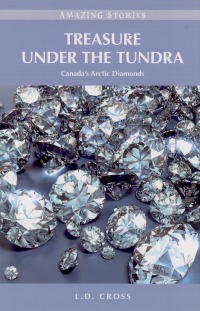| ________________
CM . . . . Volume XVIII Number 6 . . . . October 7, 2011
excerpt:
Treasure Under the Tundra is about the search for and discovery of diamonds in Canada's northland. On the whole, it is informative with a good explanation of what diamonds are, how they were created and where they are found. Readers learn a lot about basic geology and how geologists work. They also learn a great deal about Charles (Chuck) Fipke, the geologist who discovered what became Canada's first diamond mine, the Ekati. The exploits of Fipke in the field are very exciting. He had some amazing adventures searching for minerals in remote, hard to reach locations like New Guinea and South Africa. His experiences in Northern Canada are almost as exciting. His search for kimberlite (which has diamond indicator minerals) in Northern Canada reads much like a detective story. The geologist and the detective both have to keep a sharp eye out for clues. Without evidence of kimberlite, there are no diamonds. Without clues, there are no suspects. Treasure Under the Tundra has 10 chapters that vary in length from six to 16 pages. The book contains an index, a glossary and a bibliography. It also comes with a useful Canadian Diamond Discovery Timeline which begins in 1541 with French explorer Jacques Cartier. While Cartier believed that he had discovered diamonds, what he found were really crystals of quartz. There are also nine black and white photographs placed at various locations in the text. Apart from the pictures of Fipke and geologist, Stu Blusson, these are of little value. The shots of Canada's northland are too small to be meaningful. Treasure Under the Tundra has many scientific terms. Most of these are explained in the glossary while some are explained in the text. For a few, however, there is no explanation. These include porphyry, trilobites and electron microprobe. The lack of a definition for these terms is annoying. The glossary, while helpful, also has shortcomings which reduce its value for young readers. In the definition of kimberlite, for example, "a rare igneous rock matrix" is not helpful to someone with no previous background in geology. Unless a dictionary is consulted, this piece of information is meaningless. Readers may find Treasure Under the Tundra confusing as a result of the shortage of explanations and, as a result, quite frustrating. This reduces the book's value in the classroom. Occasionally, the style of the text is also confusing. One example deals with a horse Fipke bought. "In 2003, he paid what at the time was a world record price of $2.3 million for a yearling Tale of Ekati, foaled March 31, 2005, which was named after Ekati Mine." On first reading, it looks as if the yearling's name was Tale of Ekati purchased in 2003 but this couldn't be because Tale of Ekati was foaled in 2005. What Cross meant to say was that the yearling purchased in 2003 had a foal, Tale of Ekati in 2005. No name is given for the yearling. The author of Treasure Under the Tundra, L.D. Cross, has considerable experience as a writer. In addition to many magazine articles, she has written numerous books. These include Inside Outside, a book about how a person can take control of his/her life, and Marriage is a Business, which argues that marriage is first and foremost a political and economic match. Cross has won several awards for nonfiction writing. Recommended with reservations. Thomas F. Chambers, a retired college professor, lives in North Bay, ON.
To comment
on this title or this review, send mail to cm@umanitoba.ca.
Copyright © the Manitoba Library Association. Reproduction for personal
use is permitted only if this copyright notice is maintained. Any
other reproduction is prohibited without permission.
NEXT REVIEW |
TABLE OF CONTENTS FOR THIS ISSUE
- October 7, 2011.
AUTHORS |
TITLES |
MEDIA REVIEWS |
PROFILES |
BACK ISSUES |
SEARCH |
CMARCHIVE |
HOME |
